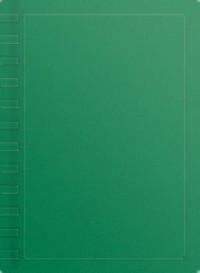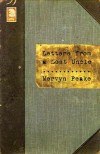Currently reading
The Witches
Invisible Cities
Jonathan Strange & Mr Norrell
The Illustrated Gormenghast Trilogy
Letters from a Lost Uncle
Wonderbook: The Illustrated Guide to Creating Imaginative Fiction
Hunting and Gathering Heaven
 Hunting and Gathering Heaven is a thin little book. It is light. Light in weight, obviously, and light in tone. But more significantly, it is light in the sense of being luminous.
The book is sectioned off into three parts—Part I: North; Part II: Kingdom of Florida; Part III: Bliss. Part I begins with “Fishing Minnesota”.
Ten thousand for the tourists,
but Uncle Ned knows
there are twelve thousand
lakes in his state.
Retired from the ore pits,
his good eye glitters
with visions
of a new vocation:
“Gonna catch one fish
from every lake,” he proclaims,
while Aunt Gloria yawns happily,
detached from her hearing aid.
Near death or childhood,
Uncle Ned has been found
singing in his workshop,
polishing lures.
Uncle Ned and Aunt Gloria make several appearances throughout the first half of Part I. Uncle Ned is a great lover of nature, fishing, and life. One could easily consider him both a guardian and a conqueror of the North—as his name, Ned Vincent, claims him to be—and of a particular way of living life without presumption and affectation. In “Genesis, Part Two” he is described as having the laughing, howling face “of a heavenly coyote.”
These poems have something to them which suggests that the world of archetype is working just beneath the surface. But our archetypes here are not grandiloquent. There is fishing, thermal underwear, and a homey old thermos full of coffee—Athey manages all of this without indulging in sentimentality, and because of this, we are not startled to come upon a poem entitled, “Anna Akhmatova”.
This is how I slept,
swaddled in moonlight, walking
on the roof of my father’s house.
Up there, a girl learned—between heaven
and earth there is a tightrope,
not a ladder.
This is how I dreamed,
with tears and grinding teeth,
while the one I loved lingered
on the spector of another
no more lovely than I
but luckier.
This is how I lost
my innocence, like the birch
making love to the sky,
making love to the earth,
with branches and roots.
This is how I married
the man I did not love; I blinked
and there appeared a bright poet
who knew romance
with words, but not with flesh
and blood.
This is how I bled
innocent bystanders, those words,
into the prison cells of paper.
This is how my heart became
a chaplain.
These poems are gripping for all their apparent simplicity. There is constantly the feeling of something not quite seen, but felt and describable only as “mystery”. One could easily argue that it is “mystery” which Athey has made his subject, and the characters, earthy and fantastic, are his supporting cast. But, it is obvious, he loves these characters, too. They are not “merely” secondary any more than you or I are secondary to the meaning of this wild life. These characters, whether fictional or not, are living creatures, eccentric and wise and foolish. One of my favorite poems appears in Part II and is titled, “Phog”.
The strangest man in Florida
is a priest from Scotland
who claims to have lunched with the Queen
Of Heaven, and to have the habit
of mentally undressing
a certain blonde virgin
as she stands before him to receive
Holy Communion.
Father Phog is a redhead who smokes
Marlboros right down to the butts.
He believes UFOs are us: humans
from the future, returning
to harvest healthier genes
from these Good Old Days!
He laughs through his ruddy nose
and slaps the hell out of his thigh.
The other day at the beach,
I asked Father Phog
if he’d ever seen the Loch Ness Monster.
Good Lord, he said, blowing smoke,
I do confess—I’ve had a glimpse or two
of that slithering beast
within.
This poem, falling almost perfectly in the center of the book, sums up the embrace of the contradictions of life which fill Athey’s poems. Life Is. It is all around us, created by the only One Who can claim to be “I AM”. Taking the “Kingdom of Florida” for the pattern, Athey tells us that
There is nothing to do
in this coeval kingdom, but be
drowned, strangled, eaten, or
grown.
It is in Part III that the book becomes most luminous. And yet, for all the mention of souls, heaven, and “godsong”, this is no detached idealism.
He is Tired of Self-Portraits of Artists, Pouting
One simple sonnet
about the white gloves
of a true lover, unpublished
in a nun’s notebook,
turns his crank
immensely.
There is the holy fool of “Love in the Ruins”, the trees “getting naked” in “Above Duluth”, the “Apophatic” theology of a crow, and the almost erotic longing “to know the uknowable” in “Proposition”.
So much of this poetry is simply good poetry, easy to read, and yet inviting one to consider longer for a few or many moments. There is no disdain to these poems, just bliss. And with “Bliss” we will end.
A glass of anything
with a friend who knows
everything you want him to know.
A musty copy
of Don Quixote
savored in an empty cafe.
A true lover
with many secrets
and few regrets.
A steady rain
that does not pour.
A glimpse or two of ever-
lasting glory.
Hunting and Gathering Heaven is a thin little book. It is light. Light in weight, obviously, and light in tone. But more significantly, it is light in the sense of being luminous.
The book is sectioned off into three parts—Part I: North; Part II: Kingdom of Florida; Part III: Bliss. Part I begins with “Fishing Minnesota”.
Ten thousand for the tourists,
but Uncle Ned knows
there are twelve thousand
lakes in his state.
Retired from the ore pits,
his good eye glitters
with visions
of a new vocation:
“Gonna catch one fish
from every lake,” he proclaims,
while Aunt Gloria yawns happily,
detached from her hearing aid.
Near death or childhood,
Uncle Ned has been found
singing in his workshop,
polishing lures.
Uncle Ned and Aunt Gloria make several appearances throughout the first half of Part I. Uncle Ned is a great lover of nature, fishing, and life. One could easily consider him both a guardian and a conqueror of the North—as his name, Ned Vincent, claims him to be—and of a particular way of living life without presumption and affectation. In “Genesis, Part Two” he is described as having the laughing, howling face “of a heavenly coyote.”
These poems have something to them which suggests that the world of archetype is working just beneath the surface. But our archetypes here are not grandiloquent. There is fishing, thermal underwear, and a homey old thermos full of coffee—Athey manages all of this without indulging in sentimentality, and because of this, we are not startled to come upon a poem entitled, “Anna Akhmatova”.
This is how I slept,
swaddled in moonlight, walking
on the roof of my father’s house.
Up there, a girl learned—between heaven
and earth there is a tightrope,
not a ladder.
This is how I dreamed,
with tears and grinding teeth,
while the one I loved lingered
on the spector of another
no more lovely than I
but luckier.
This is how I lost
my innocence, like the birch
making love to the sky,
making love to the earth,
with branches and roots.
This is how I married
the man I did not love; I blinked
and there appeared a bright poet
who knew romance
with words, but not with flesh
and blood.
This is how I bled
innocent bystanders, those words,
into the prison cells of paper.
This is how my heart became
a chaplain.
These poems are gripping for all their apparent simplicity. There is constantly the feeling of something not quite seen, but felt and describable only as “mystery”. One could easily argue that it is “mystery” which Athey has made his subject, and the characters, earthy and fantastic, are his supporting cast. But, it is obvious, he loves these characters, too. They are not “merely” secondary any more than you or I are secondary to the meaning of this wild life. These characters, whether fictional or not, are living creatures, eccentric and wise and foolish. One of my favorite poems appears in Part II and is titled, “Phog”.
The strangest man in Florida
is a priest from Scotland
who claims to have lunched with the Queen
Of Heaven, and to have the habit
of mentally undressing
a certain blonde virgin
as she stands before him to receive
Holy Communion.
Father Phog is a redhead who smokes
Marlboros right down to the butts.
He believes UFOs are us: humans
from the future, returning
to harvest healthier genes
from these Good Old Days!
He laughs through his ruddy nose
and slaps the hell out of his thigh.
The other day at the beach,
I asked Father Phog
if he’d ever seen the Loch Ness Monster.
Good Lord, he said, blowing smoke,
I do confess—I’ve had a glimpse or two
of that slithering beast
within.
This poem, falling almost perfectly in the center of the book, sums up the embrace of the contradictions of life which fill Athey’s poems. Life Is. It is all around us, created by the only One Who can claim to be “I AM”. Taking the “Kingdom of Florida” for the pattern, Athey tells us that
There is nothing to do
in this coeval kingdom, but be
drowned, strangled, eaten, or
grown.
It is in Part III that the book becomes most luminous. And yet, for all the mention of souls, heaven, and “godsong”, this is no detached idealism.
He is Tired of Self-Portraits of Artists, Pouting
One simple sonnet
about the white gloves
of a true lover, unpublished
in a nun’s notebook,
turns his crank
immensely.
There is the holy fool of “Love in the Ruins”, the trees “getting naked” in “Above Duluth”, the “Apophatic” theology of a crow, and the almost erotic longing “to know the uknowable” in “Proposition”.
So much of this poetry is simply good poetry, easy to read, and yet inviting one to consider longer for a few or many moments. There is no disdain to these poems, just bliss. And with “Bliss” we will end.
A glass of anything
with a friend who knows
everything you want him to know.
A musty copy
of Don Quixote
savored in an empty cafe.
A true lover
with many secrets
and few regrets.
A steady rain
that does not pour.
A glimpse or two of ever-
lasting glory.










